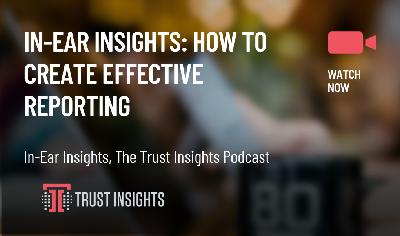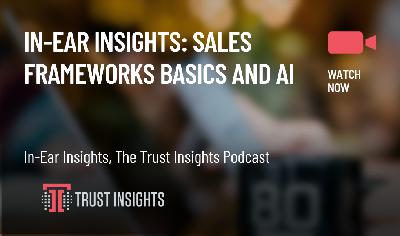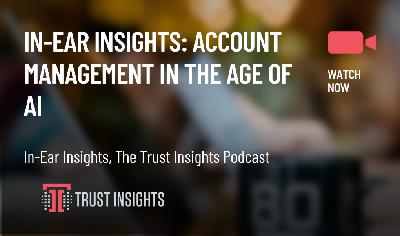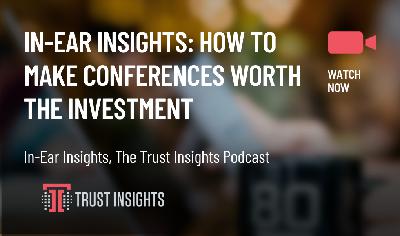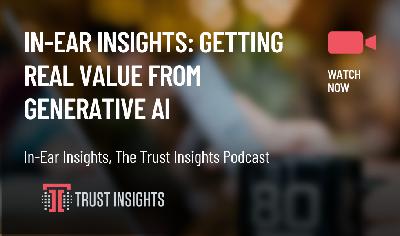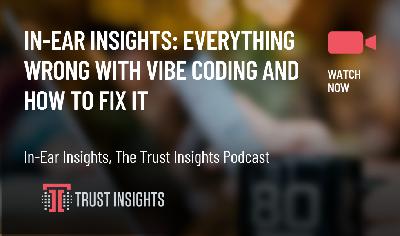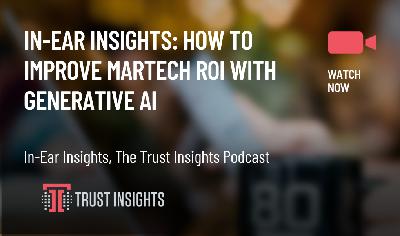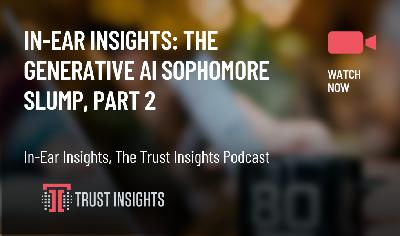In-Ear Insights: How to Create Effective Reporting
Description
In this episode of In-Ear Insights, the Trust Insights podcast, Katie and Chris discuss effective reporting and creating reports that tell a story and drive action using user stories and frameworks.
You will understand why data dumping onto a stakeholder’s desk fails and how to gather precise reporting requirements immediately. You will discover powerful frameworks, including the SAINT model, that help you move from basic analysis to crucial, actionable decisions. You will gain strategies for anticipating executive questions and delivering a clear, consistent narrative throughout your entire report. You will explore innovative ways to use artificial intelligence as a thought partner to refine your analysis and structure perfect reports. Stop wasting time and start creating reports that generate real business results. Watch now!
Watch the video here:
Can’t see anything? Watch it on YouTube here.
Listen to the audio here:
https://traffic.libsyn.com/inearinsights/tipodcast-how-to-create-effective-reporting.mp3
- Need help with your company’s data and analytics? Let us know!
- Join our free Slack group for marketers interested in analytics!
[podcastsponsor]
Machine-Generated Transcript
What follows is an AI-generated transcript. The transcript may contain errors and is not a substitute for listening to the episode.
Christopher S. Penn – 00:00
In this week’s In Ear Insights, it’s almost redundant at this point to say it’s reporting season, but as we hit quarterly ends, yearly ends, things like that, people become reflective and say, “Hey, let’s do some reports.”
One of the problems that we see the most with reporting—and I was guilty of this for the majority of my career, particularly the first half—is when you’re not confident about your reporting skills, what do you do? You back the truck up and you pour data all over somebody’s desk and you hope that it overwhelms them so that they don’t ask you any questions, which is the worst possible way to do reporting.
So, Katie, as a senior executive, as a leader, when someone delivers reporting to you, what do you get and what do you want to get?
Katie Robbert – 00:51
Well, I would start to say reports, like the ones that you were generating, hate to see me coming. Because guess what I do, Chris, I ask a bazillion questions, starting with so what? And I think that’s really the key.
As the CEO of Trust Insights, I need a report that tells me exactly what the insights and actions are so that I can do those things. And that is a user story. A user story is a simple three-part sentence: As a Persona, I want so that. If someone is giving me a report and they haven’t asked me for a user story, that’s probably step one. So, Chris, if I say, “All right, if you can pull the monthly metrics, Chris, and put it into a report, I would appreciate it.”
Katie Robbert – 01:47
If I haven’t given you a user story, you need to ask me what it is, because that’s the “so what?” Why are we doing this in the first place? We have no shortage of data points. We have no shortage of information about what happened, maybe even why it happened. And that’s a problem because it doesn’t tell a story.
What happens is, if you just give me all of that data back, I don’t know what to do with it. And that’s on me, and that’s on you. And so, together, one of us needs to make sure there is a user story. Ideally, I would be providing it, but if I don’t provide it, your first step is to ask for it. That is Step zero. What is the user story? Why am I pulling this report in the first place?
Katie Robbert – 02:33
What is it that you, the stakeholder, expect to get out of this report? What is it you need to do with this information? That is Step zero, before you even start looking at data.
Christopher S. Penn – 02:44
I love user stories, and I love them, A, for the simplicity, but B, because of that warm and comforting feeling of having covered your ass.
Because if I ask you for a user story and you give me one, I build a report for that. Then you come back and say, “But this is this.”
Katie Robbert – 03:03
This.
Christopher S. Penn – 03:03
I’m like, “You signed off on the user. You gave me the user story, you signed off on the user story. And what you’re asking for is not in the user story.” So I think we need to recalibrate and have you give me maybe some new user stories so you can get what you want. I’m not going to tell you to go F off—not my face. But I’m also going to push back and say, “This wasn’t in the user story.” Because the reason I love user stories is because they’re the simplest but most effective form of requirements gathering.
Katie Robbert – 03:36
I would agree with that. When I was a product manager, user stories saved my sanity because my job was to get all of my stakeholders aligned on a single idea. And I’ve told this before, I’d literally go to their office and camp out and get a physical signature on a piece of paper saying, “Yes, this is exactly what you’re agreeing to.”
Then, when we would sit in the meeting and the development team or the design team would present the thing, the second somebody would be like, “Well, wait,” I would just hold up the piece of paper and point to their signature. It’s such an effective way to get things done.
Katie Robbert – 04:23
Because what happens if you don’t have a user story to start, or any kind of requirements to start, when you’re doing reporting is exactly what you’re talking about. You end up with spreadsheets of data that doesn’t really mean anything. You end up with 60-slide PowerPoint reports with all of these visuals, and every single slide has at least four or five charts on it and some kind of a label. But there’s no story. There’s no, “Why am I looking at this?”
When I think about reporting, the very first thing I want to see is—and I would say even go ahead and do this, this is sort of the pro tip—
Katie Robbert – 05:00
Whatever the user story was that I gave you, put that right at the top of the report so that when I look at it, I go, “Oh, that’s what I was looking for. Great.” Because chances are, the second you walk away, I’ve already forgotten the conversation—not because it’s not important, but because a million other things have crept up.
Now, when you come back to me and say, “This is what I’m delivering,” this is what I need to be reminded of. A lot of stakeholders, people in general, we’re all forgetful. Over-communicate what it is that we’re doing here in the first place. And no one’s going to be mad at that. It’s like, “Oh, now I don’t have to ask questions.” The second thing I look for is sort of that big “So what?”
Katie Robbert – 05:45
We call it an executive summary. You can call it the big takeaway, whatever it is. At the very top of the report, I personally look for, “What is the big thing I need to know?” Is everything great? That’s all I need to know. Is everything terrible? I definitely need to know that. Do I need to take six big actions? Great, let me know that. Or, it’s all business as usual. Just give me the 30-second, “Here are the three bullet points that you need to know.” If you have no other time to read this report, that should be the summary at the top. I am going to, even if it’s not right then, dig into the rest of the report. But I may only in that moment be able to look at the summary.
Katie Robbert – 06:33
When I see these big slide decks that people present to their executive team or to their board or to whoever they report to, it’s such a missed opportunity to not have the key takeaways right there up front. If you’re asking someone to scroll, scroll, get through it—it’s all the way at the end—they’re not going to do it, and they’re going to start picking apart everything. Even if you’ve done the work to say, “But I already summarized all of that,” it’s not right there in front of them. Do yourself a favor. Whatever it is the person you’re presenting this to needs to know, put it right in front of their face immediately.
Christopher S. Penn – 07:13
Back in the day, we came up with a framework called the SAINT framework, which stands for Summary, Analysis, Insights, Next Steps, Timeline. Where I’ve seen that go wrong is people try to do too much in the summary. From Analysis, Insights, Next Steps, and Timelines, there should be one to three bullets from each that become the summary.
Katie Robbert – 07:34
And that’s it?
Christopher S. Penn – 07:35
Yeah, that’s it. In terms of percentages, what we generally recommend to people is that Analysis should be 10% to 15% of the report. What happened? Data Insights should be 10% to 15% of the report. Why did those things happen? We did this, and this is what happened. Or this external factor occurred, and this has happened.
The remaining 50% to 60% of the report should be equally split between Next Steps—what are you going to do about it?—and Timeline—when are you going to do it? Those next steps and timeline become the decisions that you need the stakeholder to make and when they need to do it so that you get done what you need to get done.
Christopher

